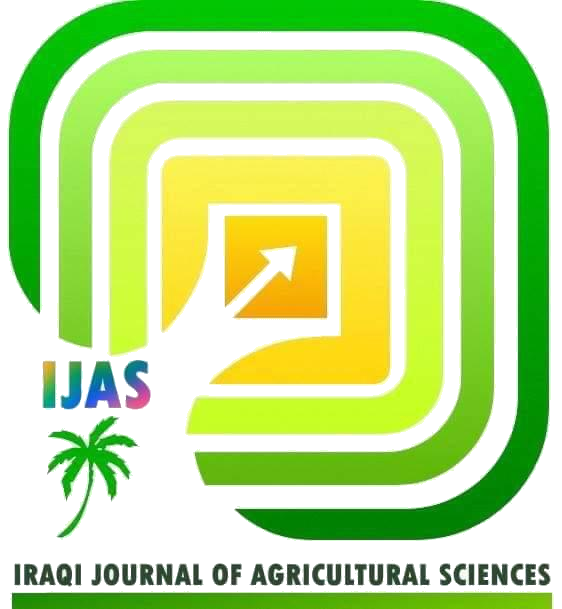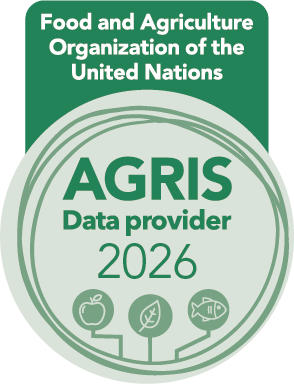REMOVING COD, N AND P FROM DAIRY WASTEWATER BY EMPLOYING LACTOBACILLUS PLANTARUM WITHIN MICROBIAL ELECTROLYSIS CELL
DOI:
https://doi.org/10.36103/hd2xy935Keywords:
Microbial electrolysis cell, potential difference, graphite electrodes, anaerobic degradation, recirculation velocity, food safetyAbstract
This study explored the capability of treating real dairy wastewater using the microbial electrochemical system by using Lactobacillus plantarum species as a microorganism. The samples were collected from a local factory for dairy products in Baghdad. Three main parameters were investigated with different levels, for estimating chemical oxygen demand (COD), phosphate (P) and nitrogen (N) removal efficiency. The studied parameters were detention time, the potential difference between electrodes and initial concentration of COD. The respective optimum values for these parameters were 17 days, 400 mV and 17000 mg COD/L respectively. At the optimum values, the optimum COD removal efficiency was 99.4%. Meanwhile, the study also performed removal efficiency for N and P due to their effects on the aquatic life and ecosystem. The optimum removal efficiency for P and N were 99% and 99%, respectively.
References
1. Adekunle, A., V. Raghavan, and B. Tartakovsky. 2019. A comparison of microbial fuel cell and microbial electrolysis cell biosensors for real-time environmental monitoring. Bioelectrochemistry. 126: 105–112.
2. Bae, H., M.H. Lee, Y. Kim, and C.W. Kim. 2003. Knowledge-based unmanned automation and control systems for the SBR wastewater treatment process. Artificial Life Robotics. 7: 107–111.
3. Bezerra C.W.B., L. Zhang, H. Liu, K. Lee, A.L.B. Marques, E.P. Marques, H. Wang, and J. Zhang. 2007. A review of heat-treatment effects on activity and stability of PEM fuel cell catalysts for oxygen reduction reaction. Journal of power source. 173: 891-908.
4. Cecconet D., M. Devecseri, A. Callegari, and A.G. Capodaglio. 2018. Effects of process operating conditions on the autotrophic denitrification of nitrate-contaminated groundwater using bioelectrochemical systems. Science of the Total Environment. 613-614: 663-671.
5. Cusick, R. D., and B. E. Logan. 2012. Phosphate recovery as struvite within a single chamber microbial electrolysis cell. Bioresource Technology. 107: 110–115.
6. Das, P. P., M. Sharma, and M. K. Purkait. 2022. Recent progress on electrocoagulation process for wastewater treatment: A review. Separation and Purification Technology. 292: 121058.
7. Feng, Y., Y. Zhang, S. Chen, and X. Quan. 2015. Enhanced production of methane from waste activated sludge by the combination of high-solid anaerobic digestion and microbial electrolysis cell with iron–graphite electrode. Chemical Engineering Journal. 259: 787–794.
8. Hassan R.Y.A., F. Febbraio, and S. Andreescu. 2021. Microbial electrochemical systems: principles, construction and biosensing applications. Sensors. 21, 1279.
9. Huang, Q., Y. Liu, and B.R. Dhar. 2020. A critical review of microbial electrolysis cells coupled with anaerobic digester for enhanced biomethane recovery from high-strength feedstocks. Critical Reviews in Environmental Science and Technology. 52:50-89.
10. Hagevoort, G. Robert Douphrate, David I., , Matthew W. Nonnenmann, Christina Lunner Kolstrup, Stephen J. Reynolds, Martina Jakob, and Mark Kinsel. 2013. The dairy industry: a brief description of production practices, trends, and farm characteristics around the world. Journal of agromedicine, 18(3), 187-197. https://doi.org/10.1080/1059924X.2013.796901
11. Haetinger, Claus Feil, Alexandre André, Dusan Schreiber, , Ângela Maria Haberkamp, Joice Inês Kist, Claudete Rempel, Alisson Eduardo Maehler, Mario Conill Gomes, and Gustavo Rodrigo and Da Silva. 2020. Sustainability in the dairy industry: a systematic literature review. Environmental science and pollution research, 27, 33527-33542.
https://doi.org/10.1007/s11356-020-09316-9
12. Jensen, L.S., C. Kaul, N.B. Juncker, M.H. Thomsen, and T. Chaturvedi. 2022. Biohydrogen production in microbial electrolysis cells utilizing organic residue feedstock: A Review. Energies. 15: 8396.
13. Jürgensen L., E. Augustine, J. Born, and J.B. Holm-nielsen. 2018. A combination anaerobic digestion scheme for biogas production from dairy effluent-CSTR and ABR, and biogas upgrading. Biomass Bioenergy. 111:1–7
14. Kadier, A., A.K. Chaurasia, S.M. Sapuan, R.A. Ilyas, W. Logroño, A.A. Hamid, and H. Abu Hasan. 2021. Essential factors for performance improvement and the implementation of microbial electrolysis cells (MECs). in bioelectrochemical systems. Springer: Singapore, 139–168.
15. Kadier, A., Y. Simayi, P. Abdeshahian, N.F. Azman, K. Chandrasekhar, and M.S. Kalil. 2016. A comprehensive review of microbial electrolysis cells (MEC) reactor designs and configurations for sustainable hydrogen gas production. Alexandria Engineering Journal. 55: 427–443.
16. Katuri K.P., M. Ali and P.E. Saikaly. 2019. The role of microbial electrolysis cell in urban wastewater treatment: integration options, challenges, and prospects. Current Opinion in Biotechnology. 57:101–110
17. Kaur, N. 2021. Different treatment techniques of dairy wastewater. Groundwater for Sustainable Development. 14: 100640.
18. Khouri, L., and M.B. Al-Mufti. 2022. Assessment of surface water quality using statistical analysis methods: Orontes River (Case study). Baghdad Science Journal. 19: 981-989.
19. Kondaveeti, S.K., J.S. Seelam, and G. Mohanakrishna. 2018. Anodic electron transfer mechanism in bioelectrochemical systems. Microbial Fuel Cell. 87-100.
20. Li, X., M. Cheng, X. Jiao, Z. Zhao, Y. Zhang, and X. Gao. 2022. Advances in microbial electrochemistry-enhanced constructed wetlands. World Journal of Microbiology and Biotechnology. 38: 239.
21. Li, J., R. Liu, S. Zhao, S. Wang, and Y. Wang. 2020. Simultaneous desalination and nutrient recovery during municipal wastewater treatment using microbial electrolysis desalination cell. Journal of Cleaner Production. 261: 121248.
22. Lim, S.S., J.M. Fontmorin, P. Izadi, W.R. Wan Daud, K. Scott, and E.H. Yu. 2020. Impact of applied cell voltage on the performance of a microbial electrolysis cell fully catalysed by microorganisms. International journal of Hydrogen Energy. 45: 2557–2568.
23. Liu H., Q. Yan, and W. Shen. 2014. Biohydrogen facilitated denitrification at biocathode in bioelectrochemical system (BES). Bioresource technology. 171:187-192.
24. Iliopoulou A., E. Zkeri, A. Panara, M. Dasenaki, M.S. Fountoulakis, N.S. Thomaidis, and A.S. Stasinakis. 2022. Treatment of different dairy wastewater with Chlorella sorokiniana: removal of pollutants and biomass characterization. Chemical technology and biotechnology. 97: 3193-3201.
25. Logan B.E., and K. Rabaey. 2012. Conversion of wastes into bioelectricity and chemicals by using microbial electrochemical technologies. Science. 337:686–690
26. Nashaat, M.R., and I.A.A. Al-Bahathy. 2022. Impact of Hindiya dam on the limnological features of Euphrates River to the north of Babil governorate, Iraq. Baghdad Science Journal. 19: 447-459.
27. Radhika, D., A. Shivakumar, D.R. Kasai, R. Koutavarapu, and S.G. Peera. 2022. Microbial electrolysis cell as a diverse technology: overview of prospective applications, advancements, and challenges. Energies. 15, 2611.
28. Rani, G. Z. Nabi, J.R. Banu, and K.N. Yogalakshmi. 2020. Batch fed single chambered microbial electrolysis cell for the treatment of landfill leachate. Renewable Energy. 153: 168–174.
29. Rozhkova, A. V., and J. A. Olentsova, 2020. Development of the dairy industry in the region. In IOP Conference Series: Earth and Environmental Science, 421 (2), 022035). IOP Publishing.
30. Reilly, M., A.P. Cooley, D. Tito, S.A. Tassou, and M.K. Theodorou. 2019. Electrocoagulation treatment of dairy processing and slaughterhouse wastewaters. Energy Procedia. 161: 343-351.
31. Rosenbaum, M., F. Aulenta, M. Villano, and L.T. Angenent. 2011. Cathodes as electron donors for microbial metabolism: Which extracellular electron transfer mechanisms are involved?. Bioresource Technology. 102: 324–333
32. Roy S., and S. Pandit. 2019. Microbial electrochemical system: principles and application. Microbial Electrochemical Technology. 19-48.
33. Sadoon, Z.A., and M.J. M-Ridha. 2019. Optimization of the electro coagulation process for the removal of cadmium from aqueous solution using RSM. Association of Arab Universities Journal of Engineering Sciences. 26: 52–64
34. Sandoval, M.A., and R. Salazar. 2021. Electrochemical treatment of slaughterhouse and dairy wastewater: Toward making a sustainable process. Current opinion in electrochemistry. 26:100662.
35. Segundo-Aguilar, A., L.V. González-Gutiérrez, V.C. Payá, J. Feliu, G. Buitrón, and B. Cercado. 2021. Energy and economic advantages of simultaneous hydrogen and biogas production in microbial electrolysis cells as a function of the applied voltage and biomass content. Sustainable Energy and Fuels. 5: 2003–2017.
36. Shen R., Z. Liu, Y. He, Y. Zhang, J. Lu, Z. Zhu, B. Si, C. Zhang, and X. Xing. 2016. Microbial electrolysis cell to treat hydrothermal liquefied wastewater from cornstalk and recover hydrogen: Degradation of organic compounds and characterization of microbial community. International Journal of Hydrogen Energy. 41: 4132-4242.
37. Stasinakis, A.S., P. Charalambous, and I. Vyrides. 2022. Dairy wastewater management in EU: Produced amounts, existing legislation, applied treatment processes and future challenges. Journal of Environmental Management. 303: 114152.
38. Tejedor-Sanz, S., J.M. Ortiz, and A. Esteve-Nú ñez. 2017. Merging microbial electrochemical systems with electrocoagulation pretreatment for achieving a complete treatment of brewery wastewater, Chemical Engineering Journal. 330: 1068-1074.
39. Wang, H., and Z.J. Ren. 2013. A comprehensive review of microbial electrochemical systems as a platform technology. Biotechnology Advances. 31: 1796–1807.
40. Wang S., N.C. Rao, R. Qiu, and R. Moletta, 2009. Performance and kinetic evaluation of anaerobic moving bed biofilm reactor for treating milk permeate from dairy industry. Biosource Technology. 100: 5641-5647
41. Wei, J., P. Liang, X. Cao, and X. Huang. 2010. A new insight into potential regulation on growth and power generation of Geobacter sulfurreducens in microbial fuel cells based on energy viewpoint. Environmental Science and Technology. 44: 3187–3191.
42. Zhao K., Y.W. Wu, S. Young, and X.J. Chen. 2020. Biological treatment of dairy wastewater: A mini review. Journal of Environmental Informatics Letters. 4: 22-31.
Downloads
Published
Issue
Section
License
Copyright (c) 2025 IRAQI JOURNAL OF AGRICULTURAL SCIENCES

This work is licensed under a Creative Commons Attribution-NonCommercial 4.0 International License.

2.jpg)


